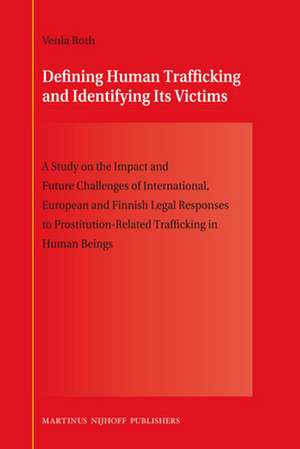Defining Human Trafficking and Identifying Its Victims: A Study on the Impact and Future Challenges of International, European and Finnish Legal Responses to Prostitution-Related Trafficking in Human Beings
Autor Venla Rothen Limba Engleză Hardback – 8 dec 2011
Preț: 867.45 lei
Preț vechi: 1057.86 lei
-18% Nou
Puncte Express: 1301
Preț estimativ în valută:
166.00€ • 172.26$ • 138.75£
166.00€ • 172.26$ • 138.75£
Carte indisponibilă temporar
Doresc să fiu notificat când acest titlu va fi disponibil:
Se trimite...
Preluare comenzi: 021 569.72.76
Specificații
ISBN-13: 9789004209244
ISBN-10: 9004209247
Pagini: 370
Dimensiuni: 160 x 240 x 25 mm
Greutate: 0.75 kg
Editura: Brill
Colecția Brill | Nijhoff
ISBN-10: 9004209247
Pagini: 370
Dimensiuni: 160 x 240 x 25 mm
Greutate: 0.75 kg
Editura: Brill
Colecția Brill | Nijhoff
Cuprins
Chapter I Introduction
1. Trafficking in Human Beings – A Topical Issue
2. Fundamentals About and Critique towards the Action against Trafficking in Human Beings
3. Research Design and Structure of the Present Study
Chapter II Consent and Vulnerability in Prostitution and Trafficking for the Purpose of Sexual Exploitation: Debates and Definitions
1. Introduction
2. Contradictory Positions on Prostitution
3. Developments in the International Law: From the Campaigns Against “White Slave Traffic” to the 1949 Convention and Beyond
4. Prostitution and Trafficking for the Purpose of Sexual Exploitation in the EU law
5. The Current International Definition of Trafficking in Human Beings and Its Relation to Prostitution
6. Conclusions
Chapter III The International Legal Framework against Human Trafficking: From the Overemphasis of Law Enforcement to the Protection of the Victim’s Human Rights
1. Introduction
2. The UN Organised Crime Convention and Its Protocols on Trafficking and Smuggling
3. The Council of Europe Convention on the Action against Trafficking in Human Beings: Added Value for the Protection of Trafficked Persons’ Human Rights?
4. Comparison of the UN Trafficking Protocol and the CoE Trafficking Convention
5. Other Relevant International Legal Instruments against Trafficking in Human Beings
6. Conclusions
Chapter IV Anti-Trafficking Strategies and Activities in Finland: Current Achievements and Future Challenges
1. Introduction
2. The Legal Framework of Action against Trafficking in Human Beings
3. The Application and Interpretation of the Penal Provisions on Trafficking at the Finnish Courts of Law: The Distinction between “Innocent” and “Guilty” Victims of Sexual Exploitation
4. Conclusions
Chapter V Conclusions and Recommendations
1. Introductory Remarks: “Invisible” Victims
2. Deserving Victims and Conditional Assistance
3. The Ambiguous Definition of Human Trafficking and the Restrictive Application and Interpretation of Criminal Law Provisions
4. Final Remarks
Bibliography; Index.
1. Trafficking in Human Beings – A Topical Issue
2. Fundamentals About and Critique towards the Action against Trafficking in Human Beings
3. Research Design and Structure of the Present Study
Chapter II Consent and Vulnerability in Prostitution and Trafficking for the Purpose of Sexual Exploitation: Debates and Definitions
1. Introduction
2. Contradictory Positions on Prostitution
3. Developments in the International Law: From the Campaigns Against “White Slave Traffic” to the 1949 Convention and Beyond
4. Prostitution and Trafficking for the Purpose of Sexual Exploitation in the EU law
5. The Current International Definition of Trafficking in Human Beings and Its Relation to Prostitution
6. Conclusions
Chapter III The International Legal Framework against Human Trafficking: From the Overemphasis of Law Enforcement to the Protection of the Victim’s Human Rights
1. Introduction
2. The UN Organised Crime Convention and Its Protocols on Trafficking and Smuggling
3. The Council of Europe Convention on the Action against Trafficking in Human Beings: Added Value for the Protection of Trafficked Persons’ Human Rights?
4. Comparison of the UN Trafficking Protocol and the CoE Trafficking Convention
5. Other Relevant International Legal Instruments against Trafficking in Human Beings
6. Conclusions
Chapter IV Anti-Trafficking Strategies and Activities in Finland: Current Achievements and Future Challenges
1. Introduction
2. The Legal Framework of Action against Trafficking in Human Beings
3. The Application and Interpretation of the Penal Provisions on Trafficking at the Finnish Courts of Law: The Distinction between “Innocent” and “Guilty” Victims of Sexual Exploitation
4. Conclusions
Chapter V Conclusions and Recommendations
1. Introductory Remarks: “Invisible” Victims
2. Deserving Victims and Conditional Assistance
3. The Ambiguous Definition of Human Trafficking and the Restrictive Application and Interpretation of Criminal Law Provisions
4. Final Remarks
Bibliography; Index.
Notă biografică
Venla Roth, Ph.D. (2010) in law, University of Turku, is Senior Officer at the Office of the Ombudsman for Minorities, who also serves as a National Rapporteur on Trafficking in Human Beings in Finland. Roth has previously published extensively on law and trafficking in human beings in Finnish and in Swedish.
